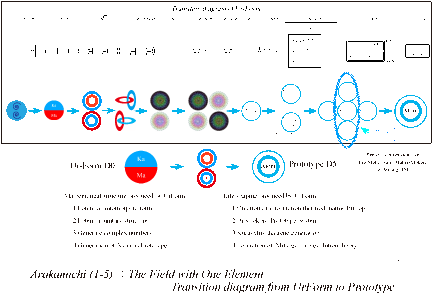Kamu Number Theory
| Contents |
|
preface
|
| Summery |
|
1.Kamu Axiom system
|
|
2.Kamu Dimension system
|
|
3.Space Time compatible Quantum
|
|
4.Topological model of Ama Universe
|
| Kamu Number Theory |
| ver.2019.10 |
| Masaki Yoshino |
| Masaki Yoshino |
| site opned 2019.2.20 |
| studying Similarity schem theory from 1975 |
| copyright (c) 2019 all rights rezerved |
| blog in English and Japanese |
1-2.Axiom from K1 to K8
| Chapter Index |
1-2-1.MaKaTama Symmetry
Spontaneous Regular-Opposite-Symmetry breaking
(Basic Principles of Kamu Number Theory)
Spontaneous Regular-Opposite-Symmetry breaking
(Basic Principles of Kamu Number Theory)
|
A4 size pdf Plate Index
|
| Preface |
| Summery |
|
|
|
1.Kamu Axiom System
|
|
|
|
1-1.Construction of Axioms
1-1-1.Axiom K and Axiom A 1-1-2.Field with one Element 1-1-3.Kamu Postulate |
|
1-2.Axiom from K1 to K8
1-2-1-1.K1,MaKaTama Symmetry 1-2-1-2.K1,spontaneous symmetry breaking 1-2-1-3.K1,UrForm and Prototype 1-2-2.K2,Mawari & Rotation 1-2-3.K3,differentiation and integration 1-2-4.K4,Kamu addition and multiplication 1-2-5.K5, Tokotachi Super Duality 1-2-6.K6, Pair Production 1-2-7.K7, Futomani 1-2-8.K8,Yata Phenomenon generation Field 1-2-9-1.What is Ka ? 1-2-9-2.What is Ma ? |
| 1-3.Axiom from A1 to A8 1-3-1.A1,Dynamic Saturation Stability 1-3-2.A2,Ama differentiation and integration 1-3-3.A3,Potential automorphic 4 Phases 1-3-4.A4,Tabane & Formal Power Series 1-3-5.A5,Imatachi & logic of Life. 1-3-6.A6, Compatibility and Duality 1-3-7.A7,Oho & Kamu forgetful Functor 1-3-8.A8,Kamuutsusi & Amautsushi |
| 1-4.Symboles inTransition Diaguram 1-4-1.First Reconsider the Operation 1-4-2.Compatible and Polymetric Additive operation 1-4-3.To Caputure Differenntial Integral with a wave image 1-4-4.Tranqull operation and Tropical Geometry |
| 1-5.Potential cuspidal automorphic form 1-5-1.Making an illustration of "Magatama Symmetry" of Axiom K-1 becomes Cuspidal automorphic form 1-5-2. Cuspidal automorphic form genetically dominating "Axiom A" |
| 1-6. Kamu imaginary Diamond and mirror symmetry 1-6-1. |
| 1-7. Axiom K-5 & 6 and the way to Carabi-Yau manifold 1-7-1. |
| 1-8. Carabi-Yau manifold to E8 Transition process and Axioms K8 |
| 1-9. Axiom A and Lie group U (1), SU (2), SU (3) |
| 1-10. Kamu Rosetta Stone |
| 1-11. Kurokawa multiple trigonometric function model |
| 1-12.Relativity-Capacitive-Quantity and Entropy 1-12-1.Reforming Boltzmann's Entropy definition formula and Information Thermodynamics 1-12-2.Guage Space and Relativity-Capacitive-Quantity |
| 1-13. Newton's map Model of Zeta function |
|
|
|
1-2-1-3・UrForm and
Precursory Complex Number Automorphic cuspidal form Model |
|
|
| The graph of the function with automorphic form correctly illustrates Regular-Opposite-Symmetry.Why, I was initially surprised by this similarity. |
| Furthermore, the existence of a deep similarity between "Graph of number theoretic Cuspidal representations of Complex variables" and "Regular-Opposite-Symmetry structure". |
| According to the explanation of the illustration, this graph has a deep relationship with "number theory".Here I noticed the existence of complex numbers in the Latent-Phenomenon world. |
| One of the remarkable things understood in the transition diagram is the process whereby complex numbers are generated. |
| "MaKa-UrForm" is promoting generation of this complex number."MaKa-UrForm" is a form of existence that is deeply involved in everything from the creation of the universe to the generation of Life. |
| "I can understand that "automorphic form" is hidden in such magnificent schema.Originally "MaKa-Regular-Oppositivity" means complex form.It is thought that this "MaKa complex structure = UrForm" is producing complex numbers. |
| The fact that the Universe is formed of complex numbers means that it is schemed by the automorphic form.In this way, I was convinced that the transition diagram was based on the similarity of number theory. |
| From the above, I decided that Axiom K-1 has elements to generate complex numbers through UrForm.In other words, the axiom K-1 shows a complicated structure in which three elements overlap as one principle. |
| It was understood from the graph of automorphic form that the following three elements are integrated in Axiom K1. |
| This is three elements of UrForm. |
|
|
| As a supplement, I will talk about UrForm. |
| "Kamu Number Theory distinguishes between UrForm and Prototype.S. Narasaki defined "Gen-shou=UrForm" and "Gen-kei=Prototype".This distinction is "UrForm of the latent phenomenon" and "Prototype of the phenomenon". |
| However, I can imagine "the appearance of UrForm" potentially having an automorphic form.The source of this image is in Axiom K-1."Potential" and "Latent-Phenomenon" can never be separated. |
 |
| Arakamichi (1-1-5) from Urform & Prototype |
| Dimension (2-7-3) kamuutsushi |